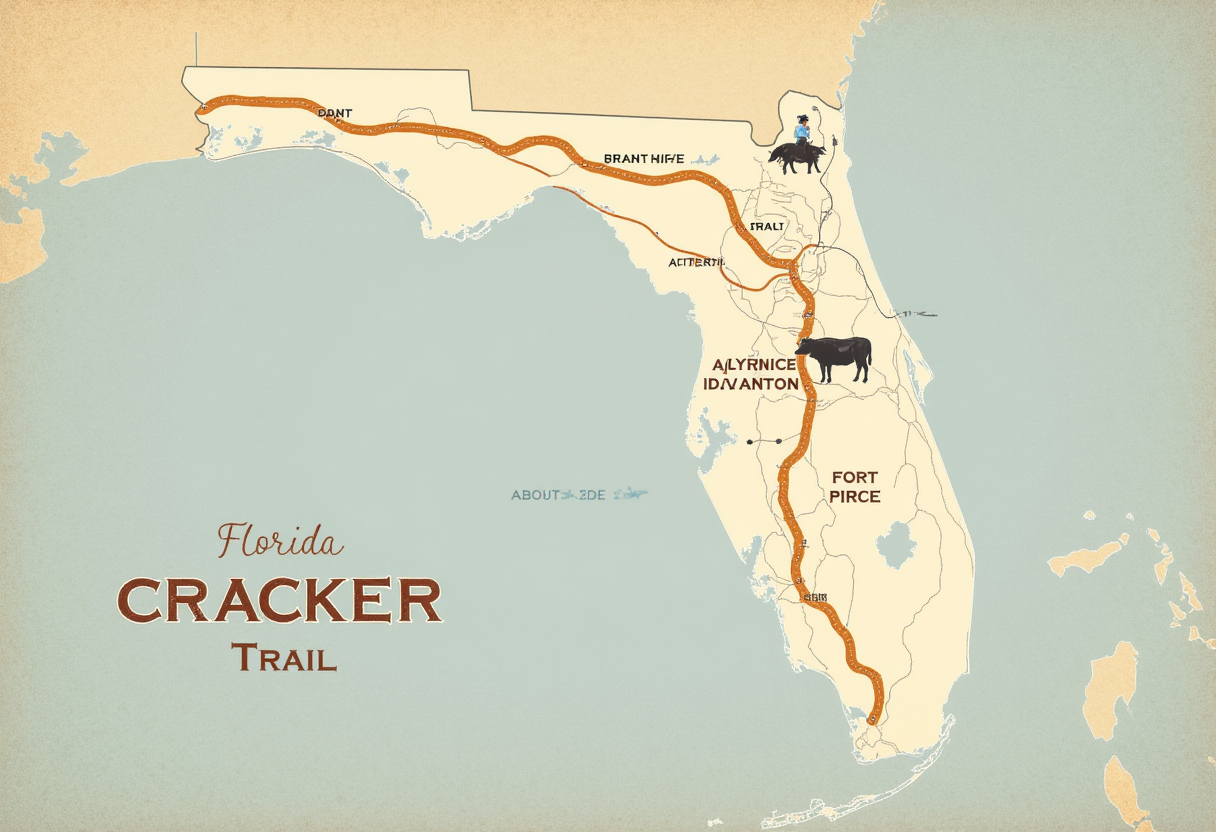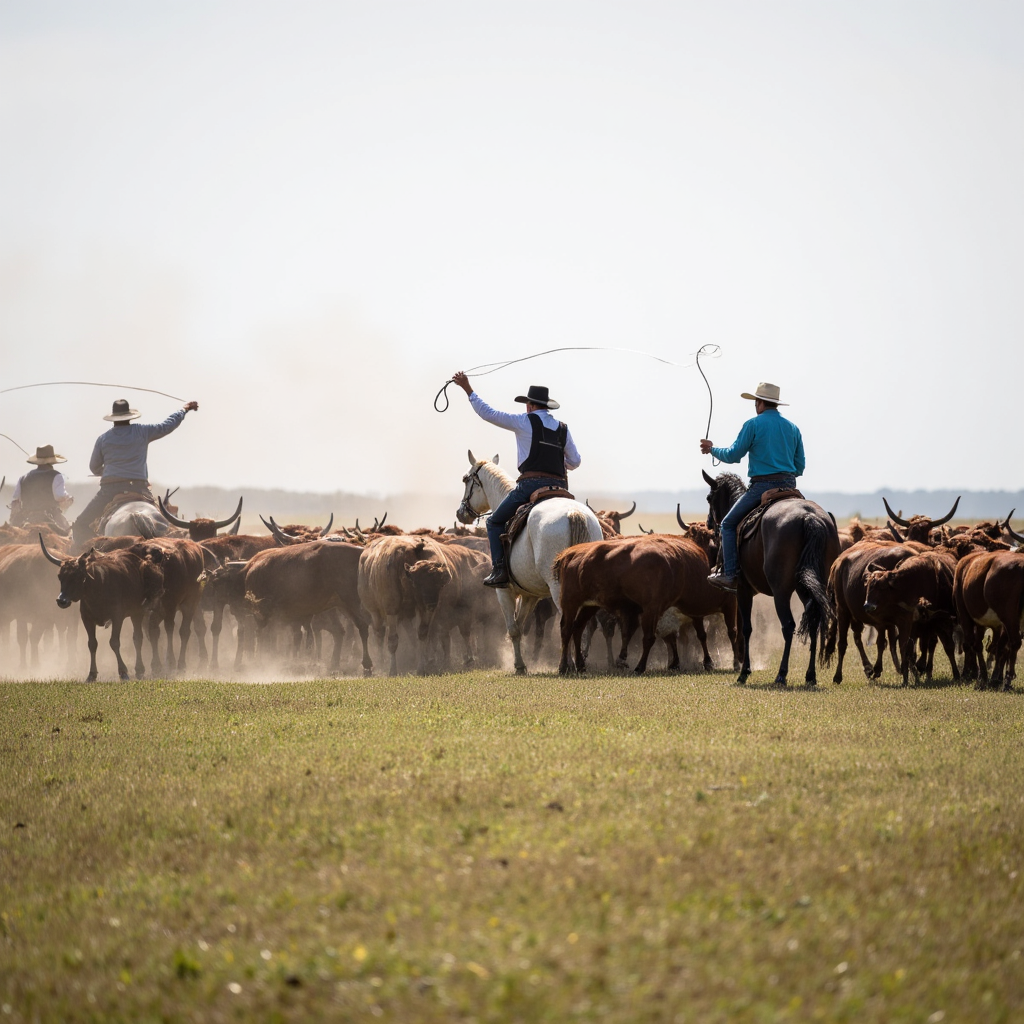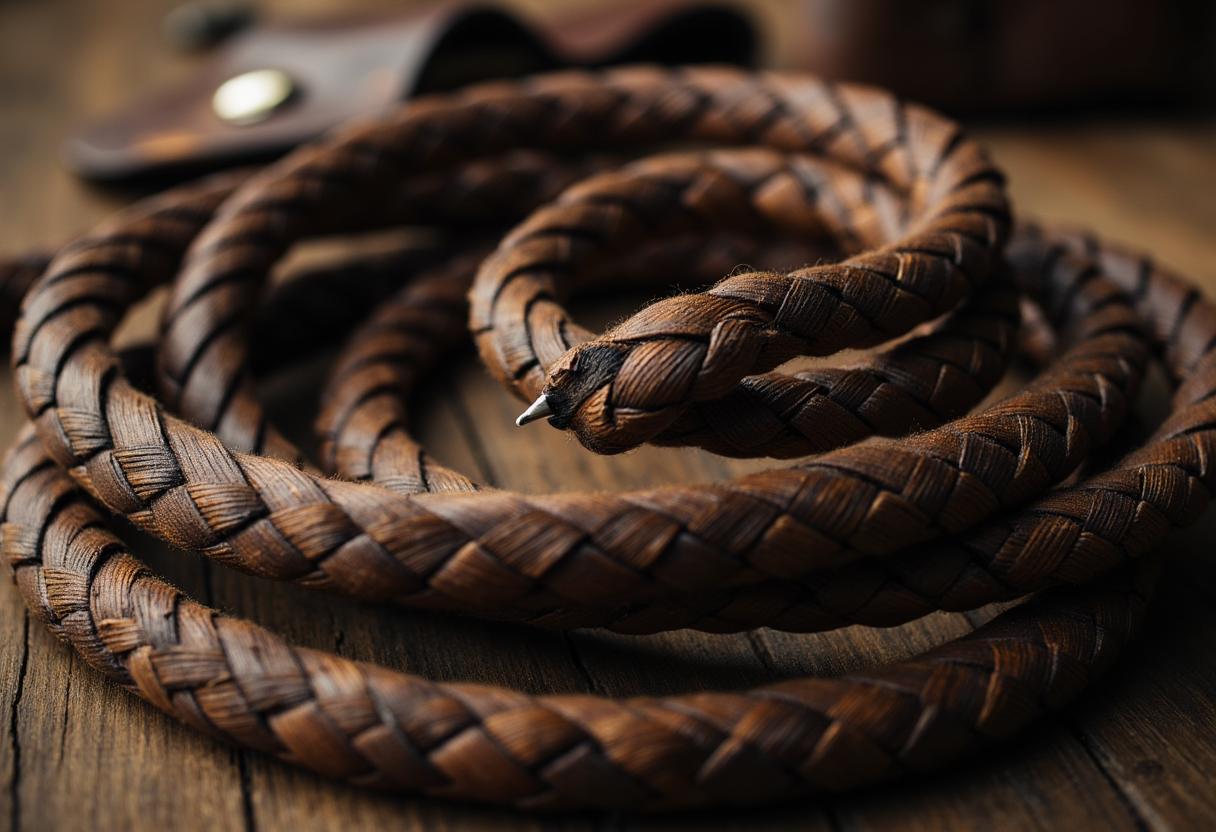Cracker Trail
A stylized map graphic that shows the historic Florida Cracker Trail stretching across central Florida, clearly marking the Gulf-side (Bradenton area) to the Atlantic-side (Fort Pierce). Overlay subtle historical elements like cattle herds or cowboys.
The word "Cracker" carries different meanings across the U.S., but in Florida, it points to a specific rural heritage. The Cracker Trail is a cross-state cattle route and a living piece of Florida history that connects Gulf-side ranching to Atlantic shipping.
These were not city slickers — they were cattlemen whose skills, landscape knowledge, and yes, the crack of a bullwhip, shaped a regional way of life.
We’ll unpack the trail’s origins, the cattle and cowboys who used it, and how that legacy is kept alive today — from museums to the annual reenacted ride.
If you’re here for history, travel tips, or a taste of authentic Florida culture, read on. For maps and visitor info, see the Florida Cracker Trail Museum and Association pages linked later in this article.
From Gulf to Atlantic: The Original Florida Express Lane (for Cows, Anyway)
Florida Cracker Trail — route & miles: In the mid- to late-19th century, ranchers needed a reliable overland route to move cattle from Gulf-side grazing lands to Atlantic shipping points. The historic Cracker Trail ran roughly 120–140 miles across central Florida, generally linking the Bradenton area on the Gulf to Fort Pierce on the Atlantic.
Picture an era without paved roads or modern transportation: vast scrub, hammocks,
and stretches of dry high ground that made a continuous cattle route possible where much of the state was otherwise wet or impassable.
Moving a herd across that landscape was a major logistical undertaking—hours and days of travel over rutted paths and through dense palmetto.
The trail functioned as essential transportation infrastructure, connecting ranch land to markets and ports on the Atlantic coast.
This was not a casual jaunt. The men who guided those herds became known regionally as "Crackers" — a name tied to the distinctive crack of the bullwhip used to control cattle, not a slur.
Their knowledge of terrain, water sources, and safe high ground made the route possible and kept cattle moving mile after mile.
The Whip-Smart History of a Not-So-Silly Name
The label "Cracker" carries complicated connotations nationally, but in Florida, its roots are practical and historic: it refers to the distinctive crack of the bullwhip used by cattlemen on the trail. Context matters when interpreting the term.
In the 19th-century cattle drives that followed the Cracker Trail, bullwhips—long, braided leather tools—were used as herding aids. The loud, sharp crack was an audible cue to move stock, startle a straggler back into line, or signal other riders across scrub and palmetto
This method of cattle handling became an identifying characteristic of Florida cowboys.
The sound itself functioned as practical communication during long drives over challenging terrain.
A herd of Florida Cracker cattle (heritage breed, lean, long-horned) being driven by several cowboys on horseback. Dust kicks up, and the cowboys are using their whips (one visibly cracking)
For readers interested in sources, state archives and contemporary 19th-century accounts document whip use on Florida cattle drives; consider adding a short bibliography or links to primary documents in the article's "Further reading" section.
Glossary note: "Florida Cracker" — a regional term historically applied to Florida cattlemen and ranching families,
tied more to herding technique and rural life than modern pejorative uses.
A Crackin' Good Revival: The Florida Cracker Trail Association
The Florida Cracker Trail Association, formed in 1987, is the organization that keeps this heritage alive.
Rather than just preserving artifacts, the group stages a reenacted cross-state ride that relives the original cattle drives.
The signature event is a multi-day ride—typically nine days covering roughly 120 miles—during which participants follow historic corridors, camp roadside, and ride through central Florida landscapes that once guided cattle to market.
This ride is part living history, part endurance event: expect early mornings, campfire coffee,
and sore but satisfied riders and horses at day’s end. The Association publishes registration details, rules,
and participation requirements on its official page; prospective riders should check those resources for insurance,
mounting rules, and safety guidelines.
Interested visitors can also support the organization by attending related events or visiting the Florida Cracker Trail Museum — many riders describe the experience as a powerful way to connect with Florida’s cattle‑driving past.
Hitting the Trail: Your Own Cracker Adventure (No Whips Required)
You don’t need nine days in the saddle to experience the Florida Cracker Trail—many visitors explore key sections by car. Parts of the historic route track modern thoroughfares such as State Road 64 and State Road 66 and several U.S. Highways (U.S. Highway 17, U.S. Highway 98, U.S. Highway 441 and State Road 68), so a day trip can cover meaningful sites without packing a saddlebag.
Below are suggested stops and quick logistics to plan your drive along portions of the trail; approximate driving times between highlights are noted where helpful.
Must-See Stops on Your Cracker Quest
Highlands Hammock State Park: Ancient live oaks, cypress swamps, and easy tram tours make this a scenic first stop. Parking is available; allow 1–2 hours for a tram or short hike.
Henscratch Farms Vineyard and Winery: A pleasant detour—sample native grape wines and, if you visit in August, enjoy the grape stomp festival. Check the farm’s page for hours and event dates.
Florida Cracker Trail Museum (Zolfo Springs): The museum offers curated exhibits and pioneer-era buildings that explain the cultural and agricultural history behind the trail. Plan 1–1.5 hours; gift shop and interpretive materials available.
Paynes Creek Historic State Park: A reflective stop with Civil War and Seminole War history; great for a short hike and a quiet picnic.
close-up image of a vintage, expertly crafted braided leather bullwhip, showcasing its intricate texture and craftsmanship, with a focus on the delicate dance of the braids and the worn, weathered leather.
Historic Towns: The trail corridor touches towns such as Bradenton, Zolfo Springs, Wauchula,
Lake Placid, Sebring, and Fort Pierce. Each downtown offers local dining and historic main streets—stop for a meal, visit a local museum, or pick up supplies.
Practical tips: this is largely rural territory—expect limited cell service in spots, bring water, and check park and museum hours before you go.
If you’d prefer to ride, some segments host organized horse rides; contact the Florida Cracker Trail Association for specifics on ride days and permitted equine access.
For a printable itinerary and maps showing exact miles between stops,
see the Association’s route page and the museum’s visitor information—both resources make it easy to plan a satisfying day or multi-day tour of this unique slice of Florida.
The Best Time to Crack On (and What to Expect)
If you’re planning a visit, aim for the cooler, drier months—roughly October through April—when conditions are more pleasant for driving, hiking, or short rides. Summer brings heat, high humidity,
and frequent afternoon storms that can disrupt outdoor plans.
Trail markers and maps: the Florida Cracker Trail Association has placed markers at many key sites and publishes route maps on its web page; carry a map or GPS because signage is helpful but not continuous.
What to pack: water, sunscreen, insect repellent, sturdy shoes, and a basic first-aid kit. If you plan to ride, confirm permitted equine access and ride days with the Association in advance.
About the cattle: Florida Cracker cattle are a heritage breed adapted to the state’s climate—hardy, disease‑resistant, and historically central to local transportation of livestock and regional agriculture.
For maps, schedules, and heritage‑breed resources, check the Association’s page and museum listings before you go.
Beyond the Beef: A Unique Slice of Florida Life
The Cracker Trail offers a genuine counterpoint to Florida’s theme-park image — a chance to explore the rugged, pioneering spirit that helped shape the state's rural landscape and economy.
In Florida, "Cracker" is often a term of regional respect tied to ranching families, cattle drives, and lives lived close to the land.
The Cracker Trail is more than a route on a map; it’s a thread in the state’s cultural history that you can still follow today.
Plan your visit: check the Florida Cracker Trail Association for ride dates and maps, visit the Florida Cracker Trail Museum for exhibits, or stop in a nearby downtown to sample local food and history. For sources and further reading, consult the Association’s page and state archives linked below.
Ready to explore? Use the museum and Association pages to download maps, plan a day trip or a longer tour, and learn how you can support the organization that keeps this history alive.
"Thanks for reading. Until next time, keep exploring Florida's peculiar charm!"
Florida Unwritten Staff



